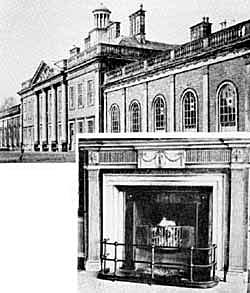< Previous | Contents | Next >
Colwick Hall
 |
COLWICK HALL (now a licensed house attached to the Nottingham racecourse at Colwick Park) stands on a site which has been occupied ever since Saxon days, and the names of its owners are legion. In the time of the Domesday survey it was held by a certain Waleraum, and it would be profitless to enumerate the names of his successors. Suffice it to say that the first use of the name Colwick as a surname occurs when Reginald de Colwick witnessed a charter on 17 November, 1225.
A curious thing abo at Colwick is that rent seems to have been paid in weapons of war, for in 1280 died "Sir Reginald de Colwyck’’ who, by the way, lived to be a centenarian— and it was declared that he held his lands ‘ of the fee of Peveril by twelve barbed arrows when he came to Nottingham," and that so late as 1504 the Byrons held Colwick "by the service of twelve crossbows yearly if asked for."
On the death of William de Colwick in 1362, the estate passed by the marriage of his daughter Joan, into the Byron family, who held it until about 1660, when it caine into the possession of the Musters.
All the older buildings disappeared when the present Hall was erected in 1775, soon after the coming-of-age of John Musters, father of the husband of Byron’s " Mary."
There is a reed-grown lakelet in the grounds which is a remnant of an artificial water course conducting the waters of the Trent to turn a mill which existed just below the hall ever since Saxon days, and the constant disputes between the owners of Colwick and their neighbours concerning the amount of water that it was allowable to divert from the main river, are of great interest, for at one time so much water was taken that the navigation of the river was impeded.
Terrible damage was done to the contents of the Hall by the Reform Bill rioters from Nottingham in 1831. They attacked the house, armed amongst other things, with the iron railings which they had torn from Notinton Place, and after looting the contents they set fire to the building. Mr. Musters was away, and Mrs. Musters was an invalid. Fortunately she and a young lady friend managed to escape into a shrubbery, where they lay hid until their terrible danger had passed, but Mrs. Musters received a shock and chill from which she never recovered, and she passed away at Wiverton Hall some four months after the riot.
The house is worth visiting to see its magnificent Spanish mahogany doors, its moulded architraves, elegant staircase, and, above all, its wonderful fireplaces carried out in multi-coloured marbles and enriched with decoration in the style of the brothers Adam.
